In the race to combat climate change, carbon capture has emerged as a promising technology for reducing carbon dioxide (CO2) levels in the atmosphere, a major contributor to global warming. This technology has been a field of research and innovation for some years, with growing commitment to deploy adequate facilities to reach net-zero emissions and beyond. For our latest patent landscape report, Business Intelligence Consultant Sarah Fguira undertook a macro search and analysis to obtain a global overview of patent dynamics, trends, and top players active in the carbon capture technology field.
What Does Carbon Capture Technology Do?
Carbon capture technology captures and stores carbon dioxide emitted from industrial processes or power generation facilities before it enters the atmosphere. This process helps in mitigating the impact of greenhouse gas (GHG) on climate change by storing it underground or utilizing it for other applications, such as in building materials.
The carbon capture process typically involves three main stages: capture, transportation, and storage or utilization. In the capture phase, carbon dioxide is isolated from other gases produced during combustion or industrial processes, as it can be captured from pre-combustion or directly from air. Subsequently, the captured CO2 is conveyed through pipelines or shipping vessels to geological formations for secure underground sequestration and storage, or industrial sites for utilization.
Carbon utilization serves as a dual opportunity to reduce and reuse emissions, offering a compelling incentive to deepen efforts and advancements in this field.
What do patent dynamics tell us about the innovation status of this technology?
To understand the innovation and R&D activities in this technology, we performed a macro search using our proprietary IP intelligence software. By analyzing the patents collected using our IP consulting services expertise, we were able to create a global insight into research advancement and investment in this field.
In total, the patent families collected from 2004 till present are around 50,000 which are related to carbon capture, storage, and utilization.
The patent filing in the domain of carbon capture has been increasing over the last 20 years with a strong growth trend since 2021, which could be linked to increasing interest in this field due to the environmental regulations and policies driving the public and private sectors to innovate in the field of carbon capture technology.
Over the past decade, most patent families have either been granted or are currently pending, compared to dead ones. This trend signals a surge in development efforts, largely propelled by market demand for solutions and technologies aimed at reducing carbon emissions. In addition, it underscores the growing recognition of the potential value derived from the creation of other products using the captured CO2 in various fields.
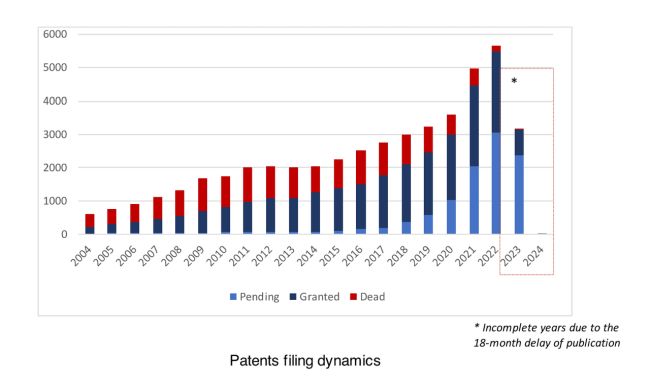
Geographical Hotspots for Carbon Capture Technology
Analyzing priority countries in patent filings reveals the most innovative nations currently active in the research and development (R&D) of carbon capture technologies. Asia is the most contributing continent with four countries, China, Japan, Korea, and India. China is the leading country with the highest number of patent filings over the past decade. This could be interpreted as China, being the world's largest emitter of CO2, facing heightened pressure to reduce its carbon footprint. Consequently, there is an increased incentive for R&D to meet government targets for CO2 emission reduction, particularly through the advancement of carbon capture technology. The U.S. is also actively working on this technology, with second position among the top 10 filing countries with a constant filing trend since 2013, followed by Japan and Korea. European countries appear among the leading countries in this domain with fewer patent families in the same time range.
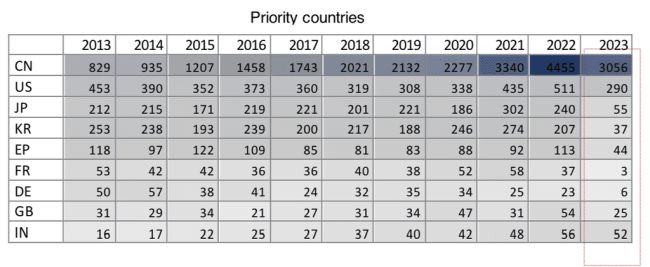
Market Coverage for Carbon Capture Technology
More than 50% of the inventions have been published in China and the U.S., as they are the main innovative countries with the highest number of patent families filing followed by Europe, Japan, and Korea. Canada also appears among the most important protected markets due to its commitment towards climate mitigation and the potential of its market.
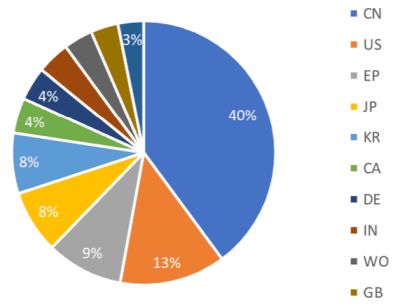
Carbon Capture Technology: Top Players
Although the database has around 50,000 inventions in total, none of the top players exceeds 1,000 patent families, indicating the diversity of the market and the number of players working on emerging technologies in the carbon capture technology field.
Most of the main players are Chinese industrial or academic organizations. The industrial firms are mostly in the energy field developing solutions for carbon capture.
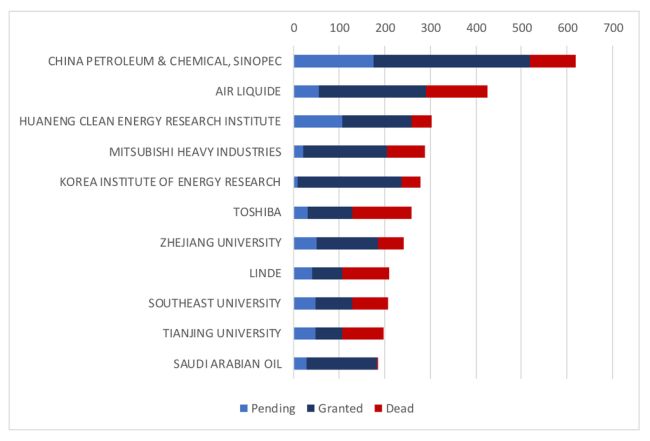
- SINOPEC, an oil and gas company, is leading the top players, with 600 patent families of which 83% are alive and 342 are granted. Most patent families are protected in China with few being extended. This reflects the commitment toward the carbon emission reduction adopted by the company. Its green and low carbon efforts have been rewarded with the title of 'China Low-Carbon Model'. One of its projects, the Qilu-Shengli Oilfield million-tonne carbon capture, utilization and storage (CCUS) demonstration project was completed and put into operation in August. SINOPEC has had a steady filing over the past decade with a peak in 2021 (78 patent families).
- Air Liquide, a gas supplier company with a notable experience in the field of carbon capture, has more than 400 patent families, of which 234 patent families are granted and around 60% are alive. Although its filing is less sizeable than SINOPEC in terms of patent families number given fluctuations over the last 10 years, it increased considerably in 2020 with 39 patent families and Air Liquide has commercialized solutions for the carbon capture and liquefaction of CO2.
- Huaneng Clean Energy Research Institute (CERI), part of the Huaneng Group (CHNG) and one of the leading public electricity companies in China, holds nearly 300 patent families (85% alive, 151 granted). Its filing trend has been increasing since 2013 with a remarkable increase noticed between 2020 and 2021 (18 and 68 patent families respectively) this reflects the approach adopted by China toward carbon footprint reduction.
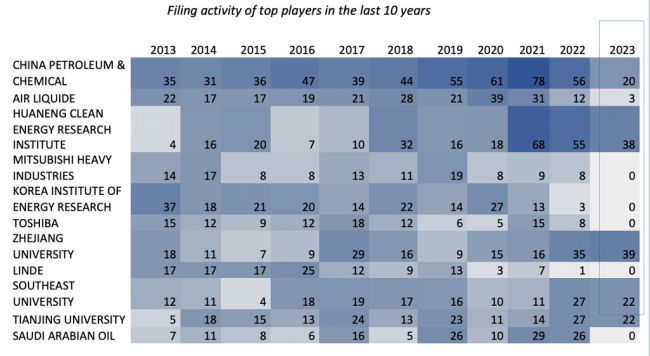
Promising applications of captured CO2
In addition to CO2 storage, technologies for the utilization of carbon dioxide have been developed to create products to generate economic value while contributing to the mitigation of CO2 emissions. One of the major uses is in enhanced oil recovery (EOR), where CO2 is injected into oil reservoirs to increase oil production while simultaneously capturing and storing CO2 underground.
Other emerging carbon utilization technologies and applications relate to mineralization and the use of CO2 in cement manufacturing notably aggregates carbonation.
For our patent landscape report, we analyzed patent filing data with a focus on the building segment in the carbon capture and utilization segment. It revealed that this segment is still in development and represents a small, limited dataset, with each of the top players in the carbon capture domain holding only a few patents.
Players such as Taiheiyo Cement, Denka, Solidia Technologies, and JFE Steel are among the most active in terms of filing and protecting innovation related to the capturing and utilization of CO2 in the cement manufacturing industry. We also found academic institutions, such as the Korea Institute of Geoscience and Mineral Resources and Hubei University of Technology, to have been engaged in recent years.
Exploring the locations of R&D in the cement industry using carbon dioxide capture shows that the top active countries are none other than China, the U.S., Japan, and Korea where the patents have been first filed.
In terms of protection countries, China by far has the biggest market coverage, as most patents are not extended Chinese patent families. Following are the U.S., EP, Japan, and Korea. Australia, Canada, and India are also among the top protected countries, reflecting the fact that all these countries are making efforts to mitigate carbon emissions.
What Comes Next for Carbon Capture Technology?
By offering an effective method to enhance product quality while simultaneously mitigating carbon dioxide emissions, carbon capture technology provides a pivotal step towards a greener and more sustainable world.
The rising interest observed in our patent landscape report underscores a growing awareness of the significance of such technologies in combating climate change. By utilizing captured CO2, organizations can not only contribute to reducing greenhouse gas emissions but also embrace responsibility toward fostering a circular economy.
As we hope this patent landscape report on carbon capture technology illustrates, patent dynamics can provide valuable insights into research and innovation trends and markets. For further details on patent activity in this sector or for specific advice or support on any other topic, contact the Questel IP Consulting team.
Sarah Fguira is a Business Intelligence Consultant at Questel, specializing in IP topics. A chemical engineer with a Master's degree in Innovation Management, Sarah has more than four years' experience as a consultant working on subjects related to chemistry, food, and pharmaceuticals.
The content of this article is intended to provide a general guide to the subject matter. Specialist advice should be sought about your specific circumstances.
